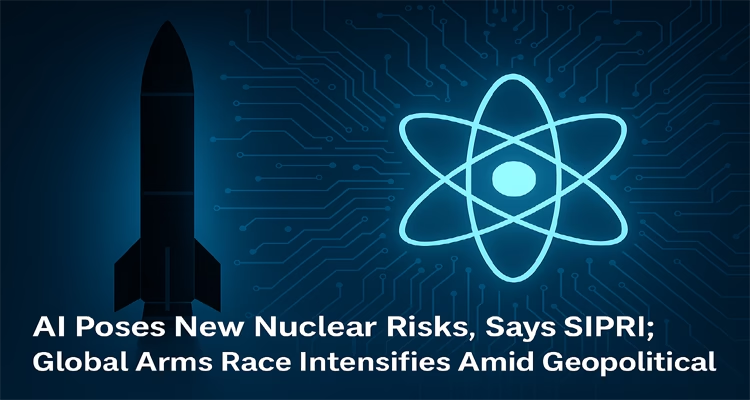
News Desk: The Stockholm International Peace Research Institute (SIPRI), in its latest yearbook, has raised alarm over the escalating threat of nuclear conflict, warning that the integration of Artificial Intelligence (AI) into military systems increases the risk of inadvertent war due to miscommunication, misjudgment, or technical failure.
In its 56th annual report, SIPRI highlighted that the complex interplay of emerging technologies and geopolitical uncertainties is redefining global security dynamics. “The idea of who is ahead in the arms race will be even more elusive and intangible than it was last time round,” noted SIPRI Director Dan Smith. He stressed that traditional arms control frameworks, based primarily on numerical limits, are increasingly inadequate in today’s rapidly evolving military landscape.
The report paints a bleak picture of the international security environment, noting the continuation of devastating conflicts in Ukraine, Gaza, and other regions, which have deepened geopolitical divisions
and humanitarian crises. Adding to global uncertainty, the re-election of Donald Trump has sparked fresh doubts in Europe and beyond regarding the future trajectory of U.S. foreign policy and its commitments to allies and international partnerships.

Growing Nuclear Arsenals and Escalating Modernization
SIPRI’s findings show a disturbing trend: the global disarmament progress achieved since the Cold War is now reversing. Nearly all nine nuclear-armed states—the United States, Russia, China, France, the United Kingdom, India, Pakistan, North Korea, and Israel—intensified efforts in 2024 to modernize and expand their nuclear capabilities.
As of January 2025, the world’s estimated inventory of 12,241 nuclear warheads includes around 9,614 held in military stockpiles for potential use. Of those, approximately 3,912 warheads are already deployed with operational forces, and about 2,100 remain on high alert, ready to launch on short notice—primarily in the U.S. and Russia. China, for the first time, may now also be keeping warheads mounted on missiles during peacetime.
“The era of reductions in the number of nuclear weapons in the world… is coming to an end,” warned Hans M. Kristensen, SIPRI associate senior fellow and director at the Federation of American Scientists. “Instead, we see a clear trend of growing nuclear arsenals, sharpened nuclear rhetoric, and the abandonment of arms control agreements.”
China and India Expand Capabilities
Among the most striking revelations is China’s rapid nuclear expansion. By early 2025, China is estimated to possess at least 600 warheads and has been constructing around 350 new intercontinental ballistic missile (ICBM) silos. At its current pace—adding nearly 100 warheads annually—China could match the ICBM capacity of the U.S. or Russia by 2030, though its total warhead count would still remain significantly lower.
India, too, is gradually enlarging its arsenal and investing in more advanced delivery systems. SIPRI reports that India’s deployment of canisterized missiles, which can be transported with warheads already mounted, signals a shift toward heightened readiness. Some of these new systems could eventually carry multiple warheads per missile.
Pakistan continues to follow suit, expanding its fissile material stockpiles and developing new delivery platforms, a move that suggests its nuclear force will also grow steadily in the coming decade.
A Complex and Dangerous Future
Beyond nuclear weapons, the SIPRI Yearbook provides comprehensive data on military spending, arms production, global arms transfers, cyber threats, and space security. The report underscores that the growing fusion of advanced technologies such as AI and autonomous systems with strategic weaponry is raising the stakes—and the risks—of conflict.
As geopolitical tensions rise and arms control regimes weaken, SIPRI’s findings serve as a stark warning: the world may be entering a new era of instability, where modern warfare technologies outpace diplomatic safeguards.



